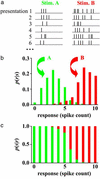Decoding neuronal spike trains: how important are correlations?
- PMID: 12775756
- PMCID: PMC165878
- DOI: 10.1073/pnas.1131895100
Decoding neuronal spike trains: how important are correlations?
Abstract
It has been known for >30 years that neuronal spike trains exhibit correlations, that is, the occurrence of a spike at one time is not independent of the occurrence of spikes at other times, both within spike trains from single neurons and across spike trains from multiple neurons. The presence of these correlations has led to the proposal that they might form a key element of the neural code. Specifically, they might act as an extra channel for information, carrying messages about events in the outside world that are not carried by other aspects of the spike trains, such as firing rate. Currently, there is no general consensus about whether this proposal applies to real spike trains in the nervous system. This is largely because it has been hard to separate information carried in correlations from that not carried in correlations. Here we propose a framework for performing this separation. Specifically, we derive an information-theoretic cost function that measures how much harder it is to decode neuronal responses when correlations are ignored than when they are taken into account. This cost function can be readily applied to real neuronal data.
Figures



References
-
- Richmond, B. J., Optican, L. M., Podell, M. & Spitzer, H. (1987) J. Neurophysiol. 57, 132-146. - PubMed
-
- Optican, L. M. & Richmond, B. J. (1987) J. Neurophysiol. 57, 162-178. - PubMed
-
- de Ruyter van Stevinick, R. R. & Bialek, W. (1988) Proc. R. Soc. London Ser. B 234, 379-414.
-
- Victor, J. D. & Purpura, K. P. (1996) J. Neurophysiol. 76, 1310-1326. - PubMed
Publication types
MeSH terms
Grants and funding
LinkOut - more resources
Full Text Sources

